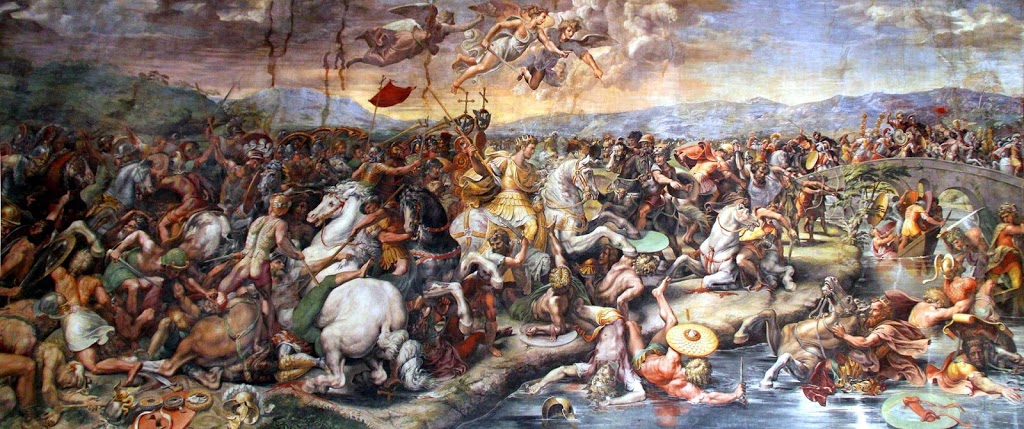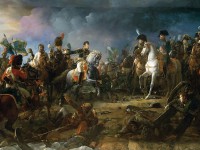
Battle of the Milvian Bridge by Giulio Romano, 1520-24
On October 28, 312 AD, the Battle of the Milvian Bridge between the Roman Emperors Constantine I and Maxentius took place. Constantine won the battle and started on the path that led him to end the Tetrarchy and become the sole ruler of the Roman Empire. According to historians, the battle marked the beginning of Constantine’s conversion to Christianity and thus fostered the rise of Christianity.
Not only Just Another One of those Roman Battles
After emperor Diocletian stepped down on 1 May 305 – a rather unusual act for a Roman emperor – his successors began to struggle for control of the Roman Empire almost immediately. Although Constantine was the son of the Western Emperor Constantius, the Tetrarchic ideology did not necessarily provide for hereditary succession. When Constantius died on 25 July 306, his father’s troops proclaimed Constantine as Augustus in Eboracum (York). In Rome, the favorite was Maxentius, the son of Constantius‘ imperial colleague Maximian, who seized the title of emperor shortly after on 28 October 306. But whereas Constantine’s claim was recognized by Galerius, ruler of the Eastern provinces and the senior emperor in the Empire, Maxentius was treated as an usurper. Galerius ordered his co-Augustus, Severus, to put him down in early 307. Once Severus arrived in Italy, however, his army defected to Maxentius. Severus was captured, imprisoned, and executed. Galerius himself marched on Rome in the autumn, but failed to take the city.
Open Hostility
Constantine avoided conflict with both Maxentius and the Eastern emperors for most of this period. By 312, however, Constantine and Maxentius were engaged in open hostility with one another, although they were brothers in law. In the spring of 312, Constantine gathered his forces and decided to oust Maxentius himself. He easily overran northern Italy, winning two major battles: the first near Turin, the second at Verona.
Constantine’s Vision
It is commonly stated that on the evening of 27 October with the armies preparing for battle, Constantine had a vision which led him to fight under the protection of the Christian God. The details of that vision, however, differ between the sources reporting it. From Eusebius, two accounts of the battle survive. The first, shorter one in the Ecclesiastical History promotes the belief that God helped Constantine but does not mention any vision. In his later Life of Constantine, Eusebius gives a detailed account of a vision and stresses that he had heard the story from the Emperor himself. According to this version, Constantine with his army was marching, when he looked up to the sun and saw a cross of light above it, and with it the Greek words “[you shall] conquer“.
The Milvian Bridge
When the two armies clashed at the Milvian Bridge in Rome, Constantine won a decisive victory. The dispositions of Maxentius may have been faulty as his troops seem to have been arrayed with the River Tiber too close to their rear, giving them little space to allow re-grouping in the event of their formations being forced to give ground. The temporary bridge set up alongside the Milvian Bridge, over which many of the Maxentian troops were escaping, collapsed, and those stranded on the north bank of the Tiber were either taken prisoner or killed. Maxentius was among the dead, having drowned in the river while trying to swim across it in a desperate bid to escape or, alternatively, he is described as having been thrown by his horse into the river.

Portrait of Constantine on the front of a silver medallion, stamped 313 in Ticinum (Pavia), with Christ monogram on the helmet bush
Victory
What is certain is that Constantine finally attributed his victory at the Milvian Bridge in 312 to the support of the Christian God and now ruled unrestrictedly in the West. After the victory, he solemnly entered Rome, presenting the severed head of Maxentius to the population. Constantine met the city’s senate with respect; it has long been disputed whether the emperor then made a sacrifice for Jupiter. The senate recognized the victor as the highest ranking Augustus, but Maxentius was now stylized as a tyrant and usurper, and finally even ahistorically portrayed by Constantinian propaganda as a persecutor of the Christians. The Praetorian Guard, the military backbone of Maxentius, was dissolved. As a symbol of his victory, Constantine had a larger-than-life statue of himself made. The following year, 313, Constantine and Licinius issued the Edict of Milan, which made Christianity an officially recognised and tolerated religion in the Roman Empire. In 315 the Arch of Constantine was also consecrated.
Diana Kleiner, 23. Rome of Constantine and a New Rome, [10]
References and Further Reading:
- [1] Eusebius: The Life of Constantine
- [2] Video: The Battle at the Milvian Bridge
- [3] Constantine and the Battle of the Milvian Bridge at MilitaryHistory.about.com
- [4] Firth, John B. “Constantine the Great, the Reorganisation of the Empire and the Triumph of the Church”.
- [5] . Encyclopædia Britannica. 6 (11th ed.). 1911. p. 988.
- [6] Lactantius’ account of the Battle at the Milvian Bridge
- [7] Eusebius, Ecclesiastical History
- [8] Eusebius, Life of Constantine
- [9] Battle at the Milvian Bridge at Wikidata
- [10] Diana Kleiner, 23. Rome of Constantine and a New Rome, Roman Architecture (HSAR 252), YaleCourses @ youtube
- [11] Cowan, Ross (2016). Milvian Bridge AD 312: Constantine’s battle for Empire and Faith. Oxford, UK: Osprey Publishing.
- [12] Timeline of Roman Emperors, via Wikidata






Warfare is a fascinating subject. Despite the dubious morality of using violence to achieve personal or political aims. It remains that conflict has been used to do just that throughout recorded history.
Your article is very well done, a good read.